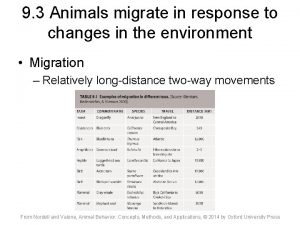Pas Most Mighty Migratory Fish This fish once









- Slides: 9

Pa’s Most Mighty Migratory Fish This fish once had a significant effect on our state and nation’s economy. It still does. And it’s had its share of obstacles over the years. How about the American shad http: //www. bing. com/videos/search? q=american+shad+videos&FORM =VIRE 13#view=detail&mid=1 F 7 FAE 028 B 50 A 3 D 62 D 971 F 7 FAE 028 B 50 A 3 D 62 D 97

Alosa sapidissima – scientific name Meaning – “Good to Eat” - The American shad is one of our state’s most important fishes. - It was once caught and eaten by Native Americans. Later, an entire fishing industry thrived around it and it fed many people. - important in the ecosystem as predator and prey. - Today is a great sportfish for many anglers - And good for our state’s outdoor recreation economy.

Shad Facts • It is the largest herring in North America • can grow up to about 24 inches and 6 pounds • It ranges along the Atlantic Coast from Florida all the way to Canada. • It likes to eat zooplankton, microcrustaceans and small fish. • This fish is quite a traveler and has a very interesting life cycle. • It is anadromous (a-’naddro-mus), which in Greek means “up-running. ” • the “anadromous” shad migratesupstream from salt water to fresh water to spawn. • The shad enters two rivers in our state by way of the Chesapeake Bay or Delaware Bay 1)Susquehanna River 2) Delaware River • • • Shad make their journey to the rivers in late spring. They spawn at night in shallow areas where the water is moving. One shad can release up to 300, 000 eggs! Most shad die after spawning, but some may survive to spawn another day. After hatching, the little shad fry live in their river nurseries until the next fall, when they start their journey back to the Atlantic Ocean. Feeding Autumn Migration Spring Migration

SPRING: Adults migrate to freshwater rivers to spawn, then return to the ocean. SUMMER: Juveniles use rivers and estuarine waters as nursery areas. FALL: Juveniles move out to the ocean, joining adults. WINTER: Juveniles stay in near-shore ocean waters until sexual maturity at 3 -6 years.

Where Have All of The Fish Gone? • Our taste for their meat and caviar (eggs) led to over-fishing, which led to population declines. • Our waterways also became polluted as our nation grew. Sewage, industrial discharges, pollution from cities, runoff from timber harvesting and siltation from farms made it hard for migratory fish to survive their journey.

• One of the biggest obstacles to migratory fish was building dams. Dams once provided the power to run mills. Today, they are used to make hydroelectricity or provide recreation. • Dams serve an important purpose in our lives, but they also block migratory fish from reaching their spawning grounds.

• American shad for the Fish & Boat Commission’s existence today. • Our agency was started in 1866 to address the declines of shad populations. • There wasn’t much success in the early years • Thanks to the efforts of the Commission, electric utilities and other groups, it now works We are able to help American shad in several different ways. • One is the agreement that state and federal agencies have on regulations. 1. These regulations restrict the harvest of American shad and other migratory fish in the rivers, bays and ocean. 2. We have programs in place to restore stream and river habitat and remove dams that block fish passage.

The fish lift at Safe Harbor Dam began operation in 1997. This fish lift, like Conowingo Dam’s lift, passes migrating fish directly into the pool above the dam. Regulations also require utilities (the dam owners) to provide fish passage at each dam that cannot be removed. These utilities have built fishways, elevators or lifts that help transport fish over the dam so they can continue their upstream migration. All four of the big hydroelectric dams on the lower Susquehanna River have fish elevators or lifts. Finally, the Commission restocks fry and migrating adults to areas above the dams so that they can reach their spawning areas. The shad fry come from eggs that are taken from adult shad and raised in a hatchery.

American shad aren’t the only fish that migrate up and down Pennsylvania’s waterways. You might be surprised to learn how many fish move between the Atlantic Ocean and Our state’s waterways. One fish even does it in reverse!
 żupan pan tadeusz
żupan pan tadeusz These are the presidents mighty mighty presidents
These are the presidents mighty mighty presidents One fish two fish red fish blue fish ride
One fish two fish red fish blue fish ride All vertebrates
All vertebrates One fish two fish blowfish blue fish
One fish two fish blowfish blue fish Schéma de la communication interpersonnelle
Schéma de la communication interpersonnelle Ne pleure pas devant ma tombe texte
Ne pleure pas devant ma tombe texte Texte lecture pas à pas
Texte lecture pas à pas Moteur pas à pas à aimant permanent
Moteur pas à pas à aimant permanent Migratory behavior
Migratory behavior















